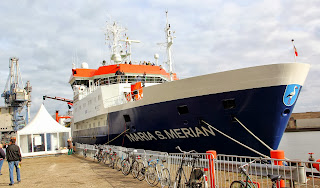Ocean Sampling Day
– Rothera’s (OSD11) delayed contribution!
 |
Picture 1 North Cove is still
covered in ice.
(Photo: Sabrina Heiser)
|
Rothera is the British Antarctic
Survey research station, located on Adelaide Island on the Antarctic Peninsula
at 67° South (http://www.antarctica.ac.uk/living_and_working/
research_stations/rothera). Like last year, we were planning to get out on the actual Ocean Sampling Day
but were stopped by the weather and ice conditions. We had fast ice in Ryder
Bay which prevented us from getting a boat in the water. However, as the ice
was staying longer and longer, we were getting very excited about the
possibility of doing a CTD and water sampling through the ice! When it was
finally signed off, we were ready to go but the wind once more was in our way.
Luckily, we were able to dive through the ice as it is closer to the shore and
less dangerous. Then, we experienced why Antarctica is called the windiest
continent on the planet. After a weekend of around 40-50 knots winds, half the
sea ice in Ryder Bay had been blown out. Luckily, this meant we were able to get
a boat into the water on the first calm day (just before the sea started
freezing again).
Picture 3 Map of Ryder Bay showing the
three CTD sites (open
circles):
1 is the main site (CTD1), 2 the secondary site (CTD2),
and 3 is the
fall-back site at Biscoe Wharf (WS3).
|
|
Picture 2 Icycles we
saw on one of our ice dives.
(Photo: Sabrina Heiser)
|
We got
out to Site 2 (67°34.850 S, 68°09.340 W) on the 22nd
of July. Site 2 is one of three sites commonly used for the RaTS (Rothera
Biological and Oceanographic Time Series) sampling (see Picture 3). We sampled
just on the edge of the fast ice. The day started off very calm, but winds were
picking up later on and finished just in time before we would have had to abort
the sampling. The air temperature was only around -5°C. The water temperature
was similar to last year -1.52°C. We deployed the CTD to 300m and winched it
back up again by hand. Afterwards we collected water samples from 15m with our
Niskin bottles.
Same as last year, we
filtered 2l for each filter. However, on the ship last summer we finally got
some Sterivex filters in which we used (4 replicates). They were frozen
immediately with liquid nitrogen and are being stored in the -80°C freezer
until the ship next March picks them up together with the samples from our
Ocean Sampling Day in the summer.
|
Picture 4 Myself and
Amber taking water samples.
|
|
Picture 5 Sampling by
the ice edge with
crabeater seals paying a visit.
(Photo: Sabrina Heiser)
|
The RaTS program includes various aspects
of sampling. With our CTD we measure depth, salinity, temperature, PAR and
fluorescence and the water samples we take back are mostly bottled up for
analysis back in the UK by a number of different institutes. We analyse
chlorophyll and ammonia in our lab here at Rothera. Whereas analyses for HPLC,
nutrients, CO2, salts, isotopes, DOC, viruses, Barium and
metagenomics is conducted elsewhere.
Sabrina Heiser,
Rothera Marine Assistant
Crew: Amber Annett
(Marine Assistant for the Dutch collaboration), Peter Webster (Diving Officer)










